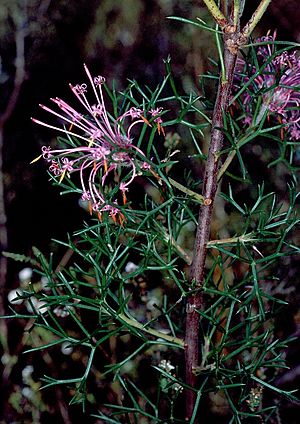Isopogon heterophyllus facts for kids
Quick facts for kids Isopogon heterophyllus |
|
|---|---|
 |
|
| Near Narrikup | |
| Scientific classification | |
| Genus: |
Isopogon
|
| Species: |
heterophyllus
|
| Synonyms | |
|
|
Isopogon heterophyllus is a special plant found only in the southwest part of Western Australia. This means it is endemic to that area. It belongs to the Proteaceae plant family. This plant is a type of shrub, which is a bushy plant smaller than a tree. It has interesting leaves that can be simple or divided. Its flowers are usually pink and a bit hairy.
What Does It Look Like?
Isopogon heterophyllus is a shrub that usually grows up to 1.2 m (3 ft 11 in) tall. It has smooth branches that are brown or reddish-brown.
Its leaves can be up to 80 mm (3.1 in) long. They can be a bit prickly. The leaves can be simple (one piece) or pinnate, which means they are divided into smaller parts, like a feather. These smaller parts can be up to 45 mm (1.8 in) long.
The flowers grow in round, ball-shaped groups called "heads." These heads are about 60 mm (2.4 in) wide. They grow directly on the ends of the branches without a stalk, which is called being sessile. Each flower head usually has pink flowers, but sometimes they can be lilac or light purple. Each flower is about 30 mm (1.2 in) long. At the bottom of each flower head, there are egg-shaped leaves called involucral bracts.
This plant flowers from August to November. After flowering, it produces a hairy nut that is about 3 mm (0.12 in) long. These nuts are joined together in a cone-shaped or round head, which is about 15–20 mm (0.59–0.79 in) wide.
How It Got Its Name
The plant Isopogon heterophyllus was first officially described in 1845. This was done by a scientist named Carl Meissner. He wrote about it in a book called Plantae Preissianae.
In 2017, two other scientists, Rye and Hislop, suggested that I. heterophyllus might actually be the same as another plant, Isopogon formosus subsp. formosus. When two plants are thought to be the same, one is called a synonym of the other. However, this idea has not yet been fully checked and accepted by the Australian Plant Census.
Where Does It Grow?
This type of isopogon plant grows in open woodlands and areas with many shrubs. It is very common and can be found in a wide area. You can see it between Cranbrook, Albany, the Stirling Range National Park, and Esperance.

